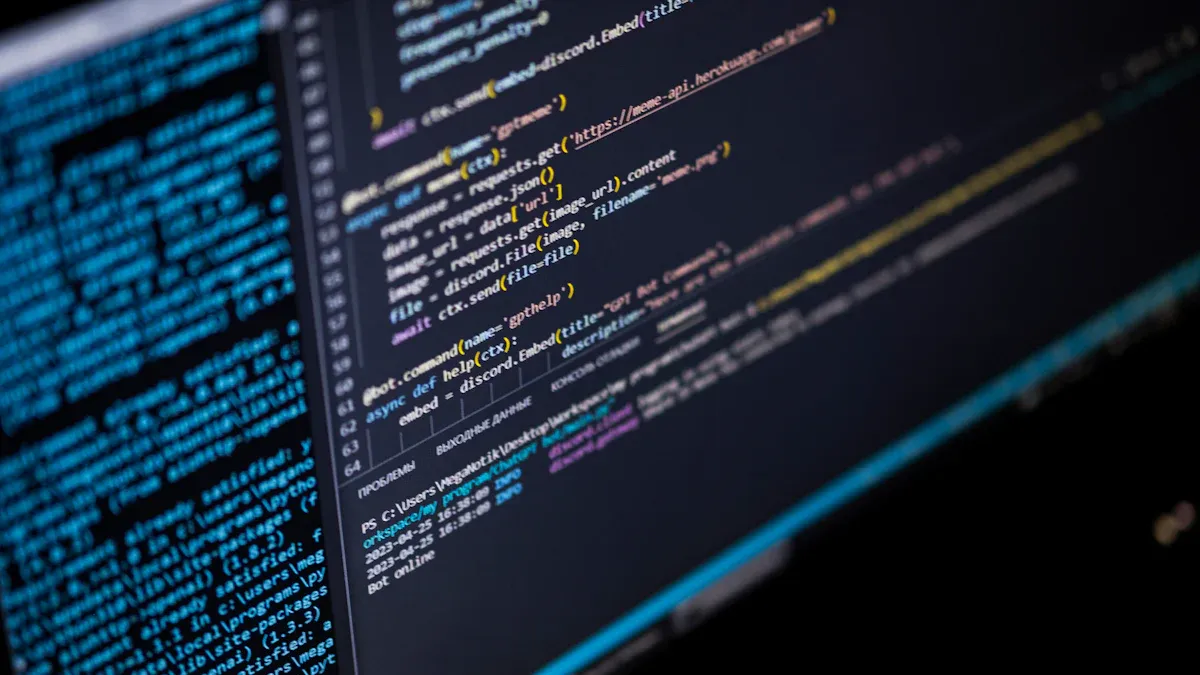
Imagine a world where your team works smarter, faster, and with fewer hiccups. That’s what open-source AI tools bring to the table in 2025. These tools aren’t just software; they’re game-changers. They help you get more done by automating tasks, analyzing data, and connecting teams in ways traditional methods can’t match.
Here’s the kicker—companies using open-source ecosystems are seeing real results. Over half report better returns on investment, and nearly 60% move AI projects from testing to full production in less than a year. Open-source tools also drive faster innovation and save valuable time, making them essential for staying ahead.
You’ll love how flexible these solutions are. Whether it’s adapting to new challenges or scaling projects quickly, open-source AI tools empower you to do more with less effort. They don’t just fit into your workflow; they transform it.
Key Takeaways
-
Open-source AI tools help teams work better by automating tasks. They also improve communication, which speeds up finishing projects.
-
AI collaboration tools make work easier by organizing information and improving workflows.
-
Smart task automation tools guess project timelines and assign resources. This lets teams focus on important decisions.
-
AI visualization tools make data analysis simple. They help show insights and check performance quickly.
-
Picking the best open-source AI tools means checking if they are clear, easy to use, and flexible for your team.
Open-Source AI Tools for Communication and Collaboration
Real-Time Chat and Video Platforms
Imagine having a virtual meeting where language barriers disappear, and everyone stays on the same page. Open-source AI tools are revolutionizing real-time communication. Platforms powered by large language models (LLMs) now offer features like live transcription, translation, and sentiment analysis during video calls. These tools make conversations smoother and more inclusive.
Take Google’s A2A, for example. It uses AI to automate onboarding tasks, cutting integration time from weeks to hours. This kind of speed is a game-changer for teams working across borders. Similarly, Anthropic’s MCP connects chatbots to corporate data securely, simplifying how teams access information during discussions.
Tip: If your team struggles with miscommunication, try open-source LLMs that enhance clarity and understanding in real-time.
AI-Powered Team Collaboration Suites
You know how frustrating it is to juggle tasks and keep everyone aligned. AI-powered collaboration suites solve this problem by automating repetitive tasks and optimizing workflows. These tools help you organize company knowledge, summarize information, and even provide intelligent search capabilities.
Companies using these suites report major efficiency gains. For instance:
-
A sales rep automated meeting notes and follow-ups, freeing up time for client engagement.
-
A senior account manager cut pitch preparation time by using AI-driven search to find relevant documents.
-
A regional sales manager boosted a junior executive’s performance with AI-generated coaching insights.
These suites also offer real-time progress tracking and smart task allocation, ensuring projects stay on track.
Tools for Cross-Team Communication
Cross-team collaboration often feels like herding cats. Open-source AI tools make it easier by fostering interoperability and seamless communication. Wildcard’s agents.json, for instance, has become a standard for auto-discovery of capabilities, enabling different teams to work together effortlessly.
During the ANP Hackathon, agents from various developers collaborated on user queries, showcasing the power of a community-driven approach. Cisco’s AGNTCY/ACP SDK further demonstrated how open-source models can achieve 10× productivity in CI/CD pipeline setups.
These tools don’t just connect teams; they create a shared language that bridges gaps and drives innovation.
Note: Open-source AI tools thrive on code transparency, ensuring everyone understands how the models work and can adapt them to their needs.
Open-Source AI Tools for Project Management
Intelligent Task Automation Platforms
Imagine having a tool that handles repetitive tasks so you can focus on the big picture. That’s what intelligent task automation platforms bring to your workflow. These open-source AI tools use large language models (LLMs) to predict project timelines, identify risks, and allocate resources based on historical data.
Here’s the kicker: AI doesn’t just save time—it boosts decision-making. By analyzing massive amounts of data, these platforms help you spot potential bottlenecks before they happen. You’ll find yourself making smarter choices and keeping projects on track.
Some key benefits include:
-
Predicting project duration with remarkable accuracy.
-
Allocating resources efficiently based on project needs.
-
Automating routine tasks to free up your schedule.
Tip: If you’re overwhelmed by manual processes, try open-source LLMs to streamline your workflow and improve productivity.
Predictive Analytics for Project Planning
Planning a project often feels like solving a puzzle. Predictive analytics powered by open-source AI tools make it easier. These models analyze past projects and current data to forecast outcomes, helping you plan smarter.
For example, machine learning models can predict delays, optimize resource allocation, and even suggest alternative strategies. This isn’t just theory—companies using predictive analytics report fewer missed deadlines and better budget management.
Take a look at the numbers:
|
Statistic |
Value |
|---|---|
|
Project management AI market growth (2024-2025) |
|
|
CAGR (2024-2025) |
16.3% |
|
Project managers using AI frequently |
21% |
|
Senior leaders believing AI will impact projects |
82% |
|
Project managers seeing AI as transformative |
58% |
|
Use of generative AI in projects |
20% |
|
Companies using project management software |
82% |
These tools don’t just predict outcomes—they empower you to act on them.
Tools for Workflow Optimization
Ever feel like your workflow could use a tune-up? Open-source AI tools for workflow optimization are here to help. These platforms use large language models to analyze your processes and suggest improvements.
For instance, AI can identify inefficiencies in your team’s communication or flag tasks that need prioritization. It’s like having a virtual project manager that never sleeps.
Here’s how they work:
-
They analyze data from multiple sources to find patterns.
-
They suggest actionable insights to improve efficiency.
-
They integrate seamlessly with other open-source tools for better collaboration.
Note: Open-source models thrive on transparency, letting you customize them to fit your unique needs.
By adopting these tools, you’ll not only optimize workflows but also foster better collaboration across teams.
Open-Source AI Tools for Coding and Development Assistance

Code Generation and Debugging Tools
Coding doesn’t have to feel like solving a maze anymore. Open-source AI tools powered by large language models (LLMs) simplify coding tasks by generating code snippets and debugging errors in real-time. These tools save you hours of searching for solutions and help you focus on building great software.
GitHub Copilot and Gemini Code Assist are leading examples. Developers using Copilot report feeling 88% more productive, while Gemini Code Assist speeds up environment setup by 55%. These tools also improve unit test coverage by 48%, ensuring your code is robust and reliable. Forrester Research found that AI-assisted development reduces production defects by up to 30%, making debugging faster and more accurate.
Tip: If debugging feels overwhelming, try open-source LLMs to spot errors and suggest fixes instantly.
AI-Powered Code Review Platforms
Code reviews often slow down development, but AI-powered platforms are changing the game. Tools like CRken automate the review process, providing detailed feedback in minutes. This rapid feedback loop reduces turnaround time on Merge Requests, enabling teams to release features up to 30% faster.
By minimizing manual reviews, these platforms enhance efficiency and reduce bottlenecks. Developers also avoid context-switching fatigue, staying focused on their tasks. CRken’s automation ensures smoother workflows, helping teams deliver high-quality software quickly.
Note: Open-source models thrive on transparency, letting you adapt them to your team’s unique needs.
Tools for Collaborative Software Development
Collaboration is the backbone of successful software projects. Open-source AI tools foster teamwork by streamlining communication and simplifying complex tasks. These tools improve code quality, with 90% of U.S. respondents and 81% of Indian respondents reporting better results. They also make it easier to learn new programming languages, with 60-71% of developers finding them helpful.
Platforms like GitHub and Wildcard enable collaborative test case generation, with over 98% of developers experimenting with AI for this purpose. Teams save time on repetitive tasks, using it for system design and brainstorming. Open-source LLMs create a shared language, bridging gaps between developers and driving innovation.
Callout: Open-source AI tools don’t just connect teams—they empower them to build smarter, faster, and better.
Open-Source AI Tools for Data Analysis and Visualization

Open-Source Data Processing Frameworks
Handling large datasets can feel overwhelming, but open-source data processing frameworks make it manageable. These frameworks are cost-effective, scalable, and flexible, giving you the tools to extract insights from structured and unstructured data.
Take Apache Spark, for example. It’s built for big data workloads and supports parallel distributed processing, which means it can split jobs across multiple computing clusters. Spark’s in-memory processing speeds up data analysis by reducing read/write operations. Compared to Hadoop MapReduce, Spark executes queries 10 to 100 times faster, thanks to its efficient execution model.
Other benefits include:
-
Easy scalability by adding nodes to handle growing data volumes.
-
High fault tolerance through data replication across nodes.
-
Compatibility with commodity hardware, saving costs.
If you’re looking for a reliable framework to process massive datasets, open-source solutions like Spark are hard to beat.
AI-Powered Visualization Tools
Visualizing complex data doesn’t have to be a headache. AI-powered visualization tools simplify the process, delivering high-quality visuals and real-time previews. These tools help you monitor systems, track metrics, and enhance visual quality—all while saving time.
For instance, D5 Render 2.10 achieves frame rates up to four times faster than traditional methods. It also improves pixel stability and visual quality, making your data presentations more polished. Real-time system monitoring ensures smooth workflows by tracking GPU and CPU usage, so you can focus on insights instead of troubleshooting.
|
Metric |
Description |
|---|---|
|
Real-time System Monitoring |
Tracks critical metrics like GPU and CPU usage for smooth workflows. |
|
Frame Rates |
D5 Render 2.10 achieves frame rates up to 4× faster than traditional methods. |
|
Visual Quality Enhancements |
AI-driven technologies improve stability and pixel quality in real-time previews. |
These tools make it easier to turn raw data into actionable insights, helping you communicate your findings effectively.
Tools for Collaborative Data Insights
Collaboration is key when analyzing data, and open-source AI tools make it seamless. These tools enable teams to share insights, work on projects together, and close achievement gaps.
For example, integrating collaborative analytics tools has led to a 24% improvement in project completion rates and a 17% reduction in time-to-mastery for complex concepts. Institutions using these tools have seen a mean GPA increase of 0.3 points and a 12-18% reduction in achievement gaps.
|
Evidence Description |
Result |
|---|---|
|
Mean GPA increase in courses using collaborative analytics tools |
0.3 points |
|
Improvement in completion rates for collaborative projects |
24% |
|
Decrease in time-to-mastery for complex concepts |
17% |
|
Reduction in achievement gaps at the institutional level |
12-18% |
These tools don’t just enhance collaboration—they empower teams to uncover deeper insights and drive innovation.
Comparison and Ranking of Open-Source AI Tools
Criteria for Evaluating Open-Source AI Tools
When you're choosing the right open-source AI tools, knowing what to look for can save you time and effort. The best tools stand out because they meet specific criteria that ensure reliability, usability, and adaptability. Here's what you should consider:
-
Data, Code, and Model Availability: The most effective tools provide open access to their data, code, and models. This transparency allows you to customize and adapt them to your needs.
-
Evaluation Metrics: Tools that use validated metrics like BLEU and ROUGE for reference-based evaluation give you a clear picture of their performance.
-
Human Scoring Rubrics: Some tools rely on human evaluation with scoring rubrics to assess the quality of their outputs. This adds a layer of trustworthiness.
-
Adversarial Testing: Tools that perform well under tricky prompts or edge cases show their robustness.
-
System-Level Testing: The best tools don’t just work in isolation. They excel when tested across the entire user journey, especially in agent-based systems.
By focusing on these criteria, you can confidently pick tools that align with your goals and workflows.
Ranking Based on Features and Usability
Now that you know what to look for, let’s dive into how some of the top open-source AI tools stack up. These rankings are based on their features, usability, and overall impact on productivity.
-
Apache Spark: If you're working with large datasets, Spark is a powerhouse. Its in-memory processing and scalability make it a favorite for data-heavy projects.
-
GitHub Copilot: For coding and development, Copilot shines. It boosts productivity by generating code snippets and debugging errors in real time.
-
Wildcard’s agents.json: This tool is a game-changer for cross-team communication. It simplifies collaboration by enabling seamless interoperability between different systems.
-
D5 Render 2.10: When it comes to visualization, D5 Render leads the pack. Its AI-powered enhancements deliver stunning visuals and real-time previews.
-
CRken: For code reviews, CRken automates the process, providing detailed feedback in minutes and speeding up development cycles.
Each of these tools excels in its domain, making them invaluable for open-source projects.
Open-source AI tools are transforming collaboration in 2025. From Apache Spark’s data processing power to GitHub Copilot’s coding assistance, these tools are helping teams work smarter and faster. Microsoft’s commitment to open collaboration and standards, like the Model Context Protocol (MCP), ensures interoperability and avoids proprietary lock-in. However, challenges like AI model accuracy (38.9%) and data security (33.5%) remain critical considerations.
To integrate these tools effectively, focus on metrics like deployment frequency and coding speed improvement. Open-source models and LLMs can enhance workflows by reducing lead times and boosting developer satisfaction. Start small—use AI tools for repetitive tasks or debugging—and scale as your team grows comfortable.
Exploring open-source AI solutions isn’t just about productivity; it’s about staying ahead. These tools empower you to innovate, adapt, and thrive in a rapidly evolving tech landscape. Dive in and see how open-source AI can reshape your future.
FAQ
What are the benefits of using open source LLMs?
Open source LLMs offer flexibility and cost savings. You can customize them to fit your needs, reducing vendor dependency. They also enhance efficiency by streamlining workflows and improving collaboration across applications like NLP and machine learning models.
How does deploying large language models impact privacy?
Deploying large language models can improve privacy by using techniques like differential privacy. These methods protect sensitive data during training and deployment, ensuring enhanced data security and privacy for your projects.
Can open source LLMs be customized for specific applications?
Yes, open source LLMs allow language model customization. You can tailor them for applications like NLP, machine learning models, or even niche industry needs. This customization boosts efficiency and ensures the models align with your goals.
How do open source tools compare to closed source ones?
Open source vs closed source LLMs boils down to flexibility and transparency. Open source tools provide access to code and training data, enabling customization and cost savings. Closed source tools often limit adaptability and increase vendor dependency.
What challenges should I consider during model deployment?
Model deployment requires careful planning for data security and privacy. You should also focus on training large language models effectively to ensure they perform well in real-world applications. Efficiency and scalability are key factors to address.








